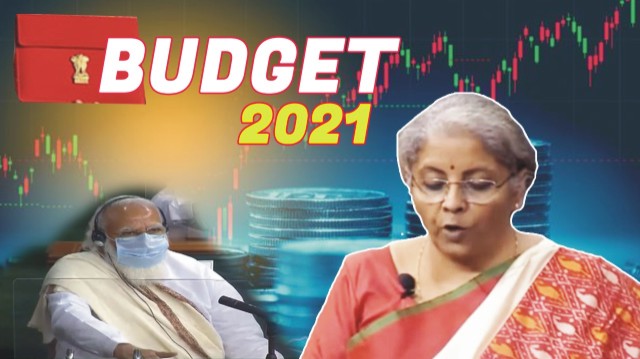

The Union Budget for financial year 2021-22 has been laid in Parliament on 1st February, 2021 by the Finance Minister. This is the first budget of the new decade and the first amid COVID pandemic with focus on unconventional areas. The Budget revolves around three themes i.e., inspirational India, economic development and caring society.
The Budget made a statement that of all the structural reforms, the Goods and Services Tax (GST) has been the most historic in our country. The Goods and Services Tax has been gradually maturing into a tax that has integrated the country economically. It has consolidated numerous taxes and cesses to one tax and facilitated formalization of economy.
 GST has resulted in the efficiency gains in logistic and transport sectors. The turnaround time for trucks has witnessed a substantial reduction to the tune of 20% due to abolition of check posts in GST. The dreaded Inspector-Raj has also vanished.
GST has resulted in the efficiency gains in logistic and transport sectors. The turnaround time for trucks has witnessed a substantial reduction to the tune of 20% due to abolition of check posts in GST. The dreaded Inspector-Raj has also vanished.
The Budget does not impose any new personal or corporate direct tax but at the same time had two garner resources for additional allocation to various sectors including infrastructure, health care, agricultural and so on.
Though there were strong chances of more taxes, cesses or surcharge in post Covid era, Government only levied one visible Cess called Agricultural and Infrastructure Development Cess (AIDC), which will be levied on one and all.
This year’s budget also breaks the taboo that rising fiscal deficit, which is presently 9.5% of GDP can be addressed only by increasing the tax revenue.
The focus is also on reducing the compliance burden which seems to be both, in direct taxes and indirect taxes. While artificial intelligence and data mining will be used more, emphasis has been on efficient tax collection, reducing paper work and compliance burden.
Further, appellate procedures are being made simple and faceless. Tax payer’s trust is also being rebuild with easing out of tax reopening norms. There will be a dispute resolution mechanism for small tax payers. There is a feel to improve tax administration, voluntary compliance, tax payment and keeping tax at reasonable levels.
 Budget looks into the future as reform in the backdrop of Covid hit country and economy. In the extraordinary circumstances, it is felt that this year’s budget is a reformative one providing a quantum leap into the future.
Budget looks into the future as reform in the backdrop of Covid hit country and economy. In the extraordinary circumstances, it is felt that this year’s budget is a reformative one providing a quantum leap into the future.
The budget also facilitates to provide a boost to public spending or expenditure for asset creation in infrastructure like roads, ports etc which will help create demand in core sectors (e.g. power, cement, steel, machinery etc).
Also, it will help job creation. It has a multiplier effect by giving more money, ensuring more spends and demand and then production, jobs, tax revenue etc. Same would apply to agriculture and health care.
Focus on capital expenditure will ensure long term asset creation and facilitate short term objectives. Infrastructure development is revealed from a 26% increase in capital infrastructure which will have a multiplier effect.
 This year’s budget is also unique in the sense that while it grows in size, it has not tinkered with taxes and barring Agriculture & Infrastructure Development cess, has kept taxes in status quo mode. Further, wherever possible, compliances have been simplified and lessened.
This year’s budget is also unique in the sense that while it grows in size, it has not tinkered with taxes and barring Agriculture & Infrastructure Development cess, has kept taxes in status quo mode. Further, wherever possible, compliances have been simplified and lessened.
AID cess takes care of additional resources required for specified purposes and would impact one and all -urban and rural, all sectors of trade and industry, small or being uniformly treating all at par and is based on consumption. The budget has focused on expansion of new opportunities for growth, providing a new dimension to youth programmes and human resources, infrastructure and growth of new sectors including start-ups.
For the first time in India’s history, health care has been positioned one of the important pillars of economy with allocation to healthcare spends being raised by 135 percent. It has earmarked Rs. 35000 crores for covid vaccine program in 2021-22 and assured of more resources on need basis.
On GST, while certain legislative changes have been proposed, it has been assured that the Government will work with GST Council to set right certain anomalies in GST laws system. Inverted duty structure in GST is an area of concern resulting in distortion in tax system and loss to revenue. GST Council is expected to address this in near future. This is more in sectors such a textile, plastic, fertilizers etc.
 The recent increase in GST collections in past 3-4 months only indicate that tax compliance can result in rise in tax revenue if tax rates are kept at reasonable levels and voluntary compliance and payments are encouraged.
The recent increase in GST collections in past 3-4 months only indicate that tax compliance can result in rise in tax revenue if tax rates are kept at reasonable levels and voluntary compliance and payments are encouraged.
Both the BSE Sensex and NSE’s Nifty have welcomed the Budget 2021-22 well. Both the indices fared family on street with both indices closing about 2.50% higher touching new highs after the budget. This can be considered as a reflection to plans to revive the economy unveiled in the Budget. However, other factors too like foreign inflows and global cues also added to the rally.
In present context, keeping spending intact holds the key to revive growth of economy which is on the edge of biggest ever annual contraction in financial year 2021-21. It should also be appreciated that this budget come in this back drop and amid tension at borders, farmer’s protest, financial sector not so strong and bad loans pile up.
Post Budget, can we now say that the claim of the Finance Minister that this year’s Budget will be like no other, the best of the century holds good? The answer could be ‘yes’ as the backdrop of this budget was like never before and none other Finance Minister so far had faced such challenges and situation like anyone else.
This was a life time crisis for everyone including the country, Finance Minister and economy. It is indeed a fine balance of political will, economic necessity and financial prudence. It is an attempt in right earnest to shore up economic recovery with basics kept in mind. However, fiscal consolidation and recovery would continue to bother the policy makers. ![]()
Also Read: The Indian Budget 2021 – Disappointing, Directionless, and Unrealistic
___________________________________
Watch video:

Disclaimer : PunjabTodayTV.com and other platforms of the Punjab Today group strive to include views and opinions from across the entire spectrum, but by no means do we agree with everything we publish. Our efforts and editorial choices consistently underscore our authors’ right to the freedom of speech. However, it should be clear to all readers that individual authors are responsible for the information, ideas or opinions in their articles, and very often, these do not reflect the views of PunjabTodayTV.com or other platforms of the group. Punjab Today does not assume any responsibility or liability for the views of authors whose work appears here.
Punjab Today believes in serious, engaging, narrative journalism at a time when mainstream media houses seem to have given up on long-form writing and news television has blurred or altogether erased the lines between news and slapstick entertainment. We at Punjab Today believe that readers such as yourself appreciate cerebral journalism, and would like you to hold us against the best international industry standards. Brickbats are welcome even more than bouquets, though an occasional pat on the back is always encouraging. Good journalism can be a lifeline in these uncertain times worldwide. You can support us in myriad ways. To begin with, by spreading word about us and forwarding this reportage. Stay engaged.
— Team PT


Copyright © Punjab Today TV : All right Reserve 2016 - 2025 |